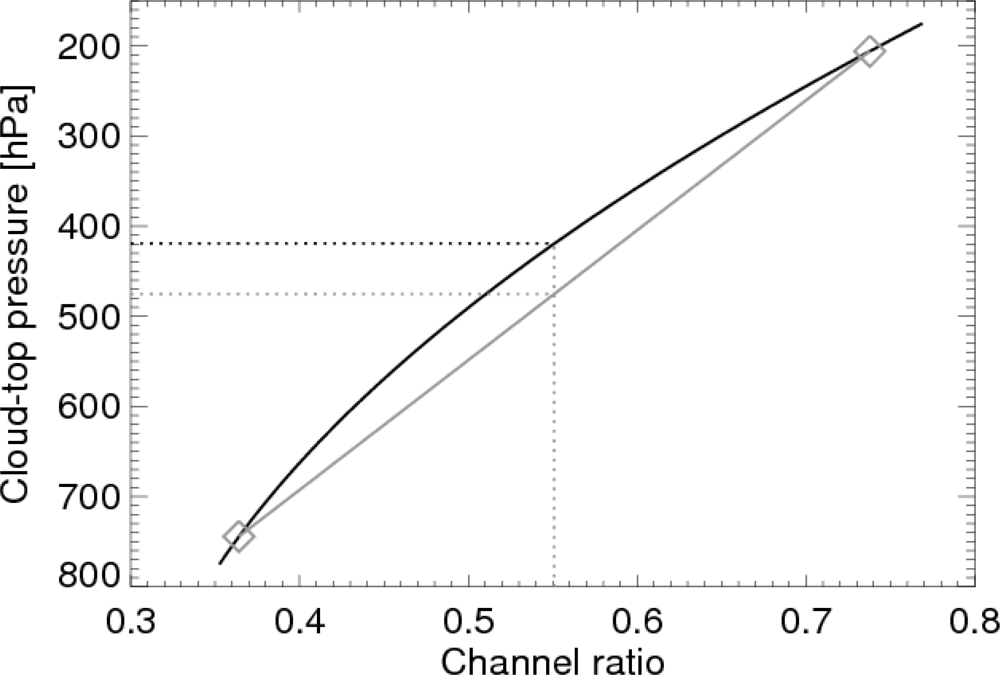The Impact of Subscale Inhomogeneity on Oxygen A Band Cloud-Top Pressure Estimates: Using ESA’s MERIS as a Proxy for DSCOVR-EPIC
Abstract
:1. Introduction
1.1. The Medium Resolution Imaging Spectrometer (MERIS)
1.2. DSCOVR-EPIC
1.3. Oxygen A Band Measurements of Cloud-Top Pressure
2. Using MERIS to Study the Effect of Degrading the Spatial Resolution
Overall Comparison
Influence of Subscale Cloud Fraction
Influence of Cloud Height
Influence of Surface Reflectance
Influence of Subscale Variability
Geographical Distribution of Errors
3. Conclusion
Acknowledgments
References
- Rast, M.; Bezy, J.L.; Bruzzi, S. The ESA Medium Resolution Imaging Spectrometer MERIS—A review of the instrument and its mission. Int. J. Rem. Sens 1999, 20, 1681–1702. [Google Scholar]
- Bourg, L.; D’Alba, L.; Colagrande, P. MERIS Smile Effect Characterization and Correction; Technical Report; European Space Agency: Paris, France, 2008. [Google Scholar]
- Yamamoto, G.; Wark, D. Discussion of the Letter by R. A. Hanel: Determination of cloud altitude from a satellite. J. Geophys. Res 1961, 66, 3569. [Google Scholar]
- Wu, M.L.C. Remote sensing of cloud-top pressure using reflected solar radiation in the oxygen A-band. J. Appl. Meteor 1985, 24, 539–546. [Google Scholar]
- Fischer, J.; Grassl, H. Detection of cloud-top height from backscattered radiances within the Oxygen A Band. Part 1: Theoretical study. J. Appl. Meteor 1991, 30, 1245–1259. [Google Scholar]
- Fischer, J.; Cordes, W.; Schmitz-Pfeifer, A.; Renger, W.; Mörl, P. Detection of cloud-top height from backscattered radiances within the Oxygen A Band. Part 2: Measurements. J. Appl. Meteor 1991, 30, 1260–1267. [Google Scholar]
- Vanbauce, C.; Buriez, J.; Parol, F.; Bonnel, B.; Seze, G.; Couvert, P. Apparent pressure derived from ADEOS-POLDER observations in the Oxygen A-Band over ocean. Geophys. Res. Lett 1998, 25, 3159–3162. [Google Scholar]
- Wang, P.; Stammes, P.; van der A, R.; Pinardi, G.; van Roozendael, M. FRESCO+: An improved O2 A-band cloud retrieval algorithm for tropospheric trace gas retrievals. Atmos. Chem. Phys 2008, 8, 6565–6576. [Google Scholar]
- Preusker, R.; Lindstrot, R. Remote sensing of cloud-top pressure using moderately resolved measurements within the oxygen A band—A sensitivity study. J. Appl. Meteor. Climat 2009, 48, 1562–1574. [Google Scholar]
- Ferlay, N.; Thieuleux, F.; Cornet, C.; Davis, A.B.; Dubuisson; Ducos, F.; Parol, F.; Riedi, J.; Vanbauce, C. Toward new inferences about cloud structures from multidirectional measurements in the Oxygen A Band: Middle-of-cloud pressure and cloud geometrical thickness from POLDER-3/PARASOL. J. Appl. Meteor. Climat 2010, 49, 2492–2507. [Google Scholar]
- Acarreta, J.R.; De Haan, J.F.; Stammes, P. Cloud pressure retrieval using the O2-O2 absorption band at 477 nm. J. Geophys. Res 2004, 109, 11. [Google Scholar]
- Vanbauce, C.; Cadet, B.; Marchand, R.T. Comparison of POLDER apparent and corrected oxygen pressure to ARM/MMCR cloud boundary pressures. Geophys. Res. Lett 2003, 30, 1212. [Google Scholar]
- Fischer, J.; Grassl, H. Radiative transfer in an atmosphere-ocean system: an azimuthally dependent matrix-operator approach. Appl. Opt 1984, 23, 1035–1039. [Google Scholar]
- Fell, F.; Fischer, J. Numerical simulation of the light field in the atmosphere-ocean system using the matrix-operator method. J. Quant. Spectrosc. Radiat. Transfer 2001, 3, 351–388. [Google Scholar]
- Hollstein, A.; Fischer, J. Radiative transfer solutions for coupled atmosphere ocean systems using the matrix operator technique. J. Quant. Spectrosc. Radiat. Transfer 2012, 113, 536–548. [Google Scholar]
- Lindstrot, R.; Preusker, R.; Ruhtz, T.; Heese, B.; Wiegner, M.; Lindemann, C.; Fischer, J. Validation of MERIS cloud top pressure using airborne lidar measurements. J. Appl. Meteor. Climat 2006, 45, 1612–1621. [Google Scholar]
- Preusker, R.; Lindstrot, R.; Fischer, J. MERIS Cloud-Top Pressure, Algorithm Theoretical Basis Document ATBD 2.3; Technical Report; European Space Agency: Paris, France, 2010. [Google Scholar]
- Fournier, N.; Stammes, P.; de Graaf, M.; van der A, R.; Piters, A.; Grzegorski, M.; Kokhanovsky, A. Improving cloud information over deserts from SCIAMACHY Oxygen A-band measurements. Atmos. Chem. Phys 2006, 6, 163–172. [Google Scholar]
- Cahalan, R.F.; Gollmer, S.; Harshvardhan. Independent pixel and Monte Carlo estimates of stratocumulus albedo. J. Atmos. Sci 1994, 51, 3776–3790. [Google Scholar]
- Heidinger, A.K.; Stephens, G.L. Molecular line absorption in a scattering atmosphere. Part III: Pathlength characteristics and effects of spatially heterogeneous clouds. J. Atmos. Sci 2002, 59, 1641–1654. [Google Scholar]
- Sneep, M.; de Haan, J.F.; Stammes, P.; Wang, P.; Vanbauce, C.; Joiner, J.; Vasilkov, A.P.; Levelt, P.F. Three-way comparison between OMI and PARASOL cloud pressure products. J. Geophys. Res 2008, 113, D15S23. [Google Scholar]




Share and Cite
Lindstrot, R.; Bennartz, R.; Preusker, R.; Fischer, J. The Impact of Subscale Inhomogeneity on Oxygen A Band Cloud-Top Pressure Estimates: Using ESA’s MERIS as a Proxy for DSCOVR-EPIC. Remote Sens. 2012, 4, 1963-1973. https://doi.org/10.3390/rs4071963
Lindstrot R, Bennartz R, Preusker R, Fischer J. The Impact of Subscale Inhomogeneity on Oxygen A Band Cloud-Top Pressure Estimates: Using ESA’s MERIS as a Proxy for DSCOVR-EPIC. Remote Sensing. 2012; 4(7):1963-1973. https://doi.org/10.3390/rs4071963
Chicago/Turabian StyleLindstrot, Rasmus, Ralf Bennartz, Rene Preusker, and Jürgen Fischer. 2012. "The Impact of Subscale Inhomogeneity on Oxygen A Band Cloud-Top Pressure Estimates: Using ESA’s MERIS as a Proxy for DSCOVR-EPIC" Remote Sensing 4, no. 7: 1963-1973. https://doi.org/10.3390/rs4071963



